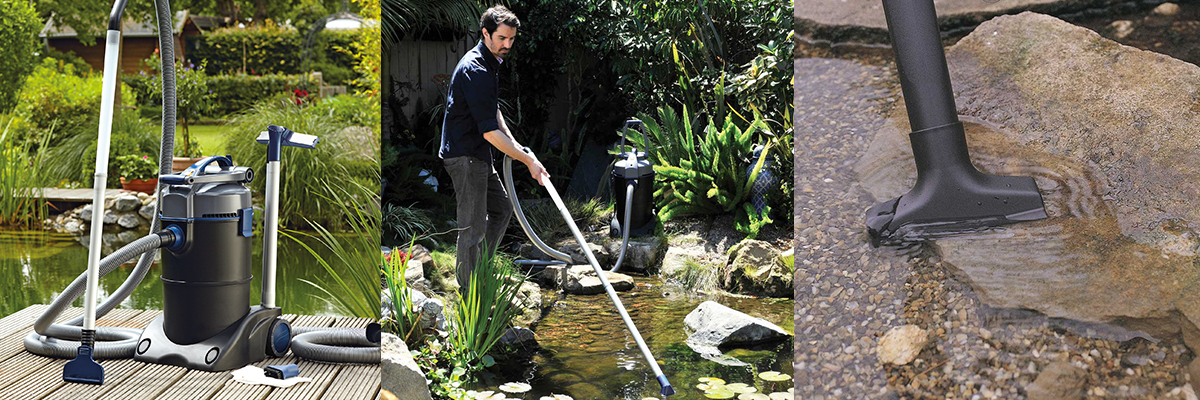How Do Pond Vacuums Work?
Pond vacuums quickly and effectively remove muck/sludge from the bottom of backyard ponds and water gardens. Organic material such as fish waste, plant debris, and excess fish food break down and settle into thick layers of muck at the bottom of water gardens. As muck continues to build up at the bottom, excess nutrients are leeched into the water creating an environment for algae to thrive.
Pond vacuums (also known as pondvacs) draw in pond muck water and discharge it away from the water garden eliminating the need to fully drain the water to remove the problematic sludge from the bottom.
How do I use a pond vacuum cleaner?
The process for vacuuming a pond may vary based on the pond vacuum being used. Most pond vacs have a suction hose used for suctioning up muck, debris, and water, and a discharge hose that empties the dirty material and water out of the vacuum.
Start by using a pond debris net to capture and remove larger material in and around the water garden. It's important to remove any larger materials to prevent blockages. Place the discharge hose away from the pond, preferably sloping away. You can even position the discharge hose to dispense into garden beds or other landscaping as the muck can be used as a fertilizer for other plants! If needed, use a mesh net bag or similar netting to capture large debris (like leaves) passed through the vacuum.
Next, place the suction hose underwater; positioning it at the bottom where you will begin to vacuum. Turn the vacuum on and move the suction intake across the bottom of the water garden in a slow and steady motion. Do not press hard against the bottom or force the suction hose into difficult areas. Moving slow will reduce the potential for disrupting settled muck and causing cloudiness. If the water garden has a pebble/gravel bottom use an gravel vacuum head to avoid suctioning the gravel and/or adjust the suction intensity.
Once vacuuming is complete, ensure the vaccum collection tank is empty. Rinse out the collection tank and other pond vacuum components such as the hoses, filters, and attachments with clean water. Lastly, check the ponds water level and add fresh water as necessary.
Are pondvacs safe for fish ponds?
Pond vacuums are designed with aquatic wildlife in mind and typically offer a variety of nozzle fittings that can help avoid accidentally harming fish or plants. However, it is up to the pond owner, or caretaker to be mindful of animals and plants in the pond. Fish are typically skittish animals to begin with and generally will avoid getting close to foreign objects moving around in the water. Avoid using a pond vacuum where fish are breeding or being spawned as fish eggs and fry can be easily vacuumed. Also, avoid using the vacuum near pond plants that require a substrate to grow, as the vacuum may inadvertently suck up the growing media.
Can I use my Wet/Dry vac to clean my pond?
Standard wet/dry vacuums are not designed for this kind of job. That's not to say you can't use one though. Here are a few reasons why you may not want to use a standard wet/dry vacuum for your pond:
- A shop vac may not be rated or tested for continuous submerged use; potentially resulting in damage to the vacuum or the pond.
- Shop vacs may not have any intensity control resulting in the vacuum suctioning up everything in its path including gravel, fish, plants, or potentially damaging the pond liner.
- Most wet/dry vacs don't have sufficient discharging capabilities, requiring the user to physically empty the collection tank when full. Constantly moving and emptying a shop vac can be a physically demanding activity; particularly when water is involved. Pond vacs save backs.
- Using the shop vacuum in a way it wasn't designed for could void any warranty on the vacuum.
Dedicated pond vacs aren't just designed for use within aquatic ecosystems they're designed to make the task of removing pond muck easier and safer; they're far more suitable for maintaining water gardens than your typical wet/dry vacuum.
How frequently should I use a pond vacuum?
To prevent debris build-up and maintain a healthy pond vacuuming can be completed as frequently as every few weeks. Not all ponds accumulate muck and debris at the same rate. Some ponds may get very little blown-in debris or may not have any fish contributing to waste build up, while other ponds may get loads of leaves falling in or may have a big population of fish. In order to nail down exactly how often you should vacuum your pond pay attention to how fast muck and debris accumulates over the course of several weeks.
How can I reduce pond muck buildup?
While you can take several different steps to reduce pond muck buildup it should be noted that there is no way to effectively eliminate it from happening in outdoor ponds. Here a several tips that can help reduce pond muck, but is not an exhaustive list:
- Remove floating and submerged debris such as leaves, sticks, or other material blown or dropped into the pond.
- Pay attention to fish feeding and don't over feed. Remove any excess, uneaten, fish food from the pond after feeding. Fish food contains a lot of nutrients and when it decays significantly adds nutrients to the water encouraging algae to bloom.
- Remove existing algae when possible. When algae dies, it decays and sinks like everything else contributing to bottom sludge.
Related Articles
How To Clean A Pond: The Complete Pond Cleaning Guide
A Guide For Cleaning And Opening Your Pond
